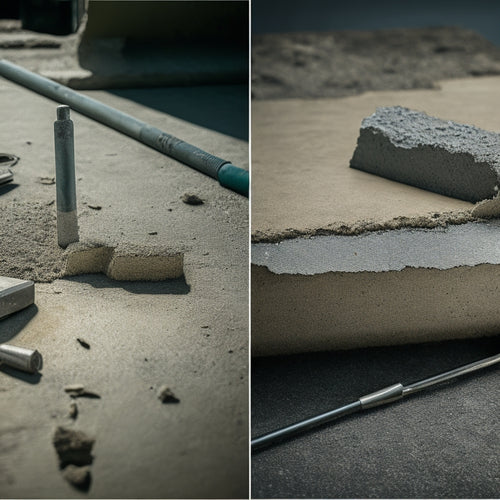
3 Must-Have Tools for Concrete Wall Demolition
Share
To successfully demolish a concrete wall, you'll need three must-have tools in your arsenal. First, a heavy-duty demolition hammer is essential for tackling thick, heavily reinforced walls, delivering massive impact forces for efficient demolition. Next, a jackhammer provides precise control and maneuverability for smaller projects, with weight, stroke length, and power source selection affecting its performance. Finally, don't forget the right safety gear, including protective eyewear, hard hats, dust masks, earplugs, and steel-toed boots, to protect yourself from the dangers of demolition work. Now that you know the basics, get ready to learn more about mastering concrete wall demolition.
Key Takeaways
• Demolition hammers are essential for heavy-duty concrete wall demolition projects, providing massive impact forces for efficient demolition.
• Jackhammers offer precise control and maneuverability for smaller concrete demolition projects, with lighter models enhancing precision.
• Hydraulic breakers are ideal for thick, heavily reinforced concrete walls, delivering high impact forces for efficient demolition.
• Safety gear, including high-quality protective eyewear, hard hats, and dust masks, is crucial for protecting against flying debris and hazardous materials.
• Correct attachments, such as demolition chisels, can enhance the effectiveness of demolition hammers and breakers for specific concrete demolition tasks.
Demolition Hammers for Heavy-Duty Work
When tackling thick, heavily reinforced concrete walls, you'll need a demolition hammer that can deliver massive impact forces to break up the toughest structures. Hydraulic breakers are ideal for this type of heavy-duty work, providing the necessary power to demolish concrete walls efficiently and safely. These powerful tools are designed to withstand the rigors of heavy demolition, making them a must-have for any serious concrete wall demolition project.
To maximize the effectiveness of your demolition hammer, you'll need the right attachments. Demolition chisels are essential for breaking up concrete and can be used in conjunction with hydraulic breakers to deliver a one-two punch to even the most stubborn structures. Always verify that you're using the correct chisel type and size for your specific project, as this will help prevent damage to the tool or injury to yourself.
Jackhammers for Precise Demolition Control
For more precise demolition control, you can opt for jackhammers, which provide greater maneuverability and accuracy compared to demolition hammers, making them ideal for smaller, more intricate concrete wall demolition projects.
When choosing a jackhammer, consider the following factors to guarantee you get the right one for your project:
| Factor | Description | Impact on Demolition |
|---|---|---|
| Weight | Lighter jackhammers provide more control, while heavier ones offer more power | Affects fatigue and precision |
| Stroke Length | Longer strokes provide more force, while shorter strokes offer more control | Affects demolition speed and accuracy |
| Vibration Reduction | Look for models with vibration-reducing features to minimize operator fatigue and improve control | Affects operator comfort and precision |
| Power Source | Electric, pneumatic, or gas-powered jackhammers each have their own advantages and limitations | Affects portability and convenience |
Safety Gear for Protection Essentials
You'll need to don the right safety gear to protect yourself from the hazards of concrete wall demolition, including flying debris, dust, and vibration. Without proper protection, you're risking serious injury or even long-term health damage.
First and foremost, invest in high-quality protective eyewear that can withstand the impact of flying debris. You don't want shattered glass or sharp concrete shards piercing your eyes. Make sure the eyewear fits snugly and has a secure strap to keep it in place.
Next, you'll need a hard hat to protect your head from falling objects or collapsing structures. A hard hat is a must-have for any demolition project, and it's especially vital when working with concrete walls. Look for a hat that meets industry standards and has a chin strap to keep it securely in place.
Don't forget to wear dust masks, earplugs, and steel-toed boots to round out your safety gear.
Frequently Asked Questions
Can I Reuse Broken Concrete for New Construction Projects?
You're wondering if you can reuse broken concrete for new construction projects. The answer is yes, and it's a great idea!
Reusing concrete offers several benefits, including reduced waste and lower material costs.
By using recycling techniques like crushing and screening, you can transform broken concrete into high-quality aggregate.
This not only reduces the environmental impact of new concrete production but also helps you build more sustainably.
How Do I Handle Asbestos During Concrete Wall Demolition?
You're about to take down a concrete wall, but suddenly, asbestos comes into play.
Don't let it catch you off guard. Before demolition, you'll need asbestos testing to identify potential hazards.
If asbestos is present, take safety precautions seriously - seal off the area, wear personal protective equipment, and use proper containment procedures.
Don't risk your health; follow local regulations and guidelines to guarantee a safe, controlled demolition process.
What Are the Noise Regulations for Demolition Work?
When you're planning demolition work, you'll need to comply with noise regulations to avoid disturbing the community and guarantee a safe work environment.
You'll need to familiarize yourself with local construction regulations, which often include noise restrictions during specific hours or in residential areas.
Make sure you understand the permissible demolition noise levels and implement measures to minimize disturbance, such as scheduling noisy tasks during designated times or using noise-reducing equipment.
Can I Demolish a Concrete Wall Without a Permit?
'Measure twice, cut once' - wise words to live by when it comes to demolition work.
Can you demolish a concrete wall without a permit? Not so fast! Check with local authorities to see if you need a permit, as demolition regulations vary.
You'll want to guarantee the structural integrity of the surrounding building isn't compromised.
Don't risk it - get permission first to avoid costly fines or even worse, a hazardous situation.
Better safe than sorry!
How Do I Dispose of Demolished Concrete Waste?
You'll need to dispose of demolished concrete waste responsibly.
Consider recycling concrete, which reduces waste sent to landfills.
Check with local waste management facilities to see if they accept concrete debris.
You may need to separate reusable materials like rebar and sort concrete by size.
Make certain you follow local regulations and guidelines for disposal, as improper disposal can lead to environmental hazards and safety risks.
Conclusion
You've got the right tools for the job, now it's time to get down to business.
Remember, concrete wall demolition is a tough nut to crack, but with a demolition hammer, jackhammer, and safety gear, you'll be breaking down walls in no time.
When the dust settles, you'll be left with a clean slate, ready to start fresh.
So, gear up and get ready to take on the challenge – it's time to knock down those walls and build something new!
Related Posts
-

Concrete Foundation Building Tools for Homeowners' Success
As you start your concrete foundation building project, it is vital to have the right tools to guarantee success. You...
-

Top Tools for Concrete Adhesion Success
When it comes to concrete adhesion success, you'll need to wield the right tools and techniques to guarantee a strong...
-

Must-Have Tools for Concrete Planter Projects
As you commence your concrete planter project, you'll need a range of specialized tools to achieve professional-grade...


